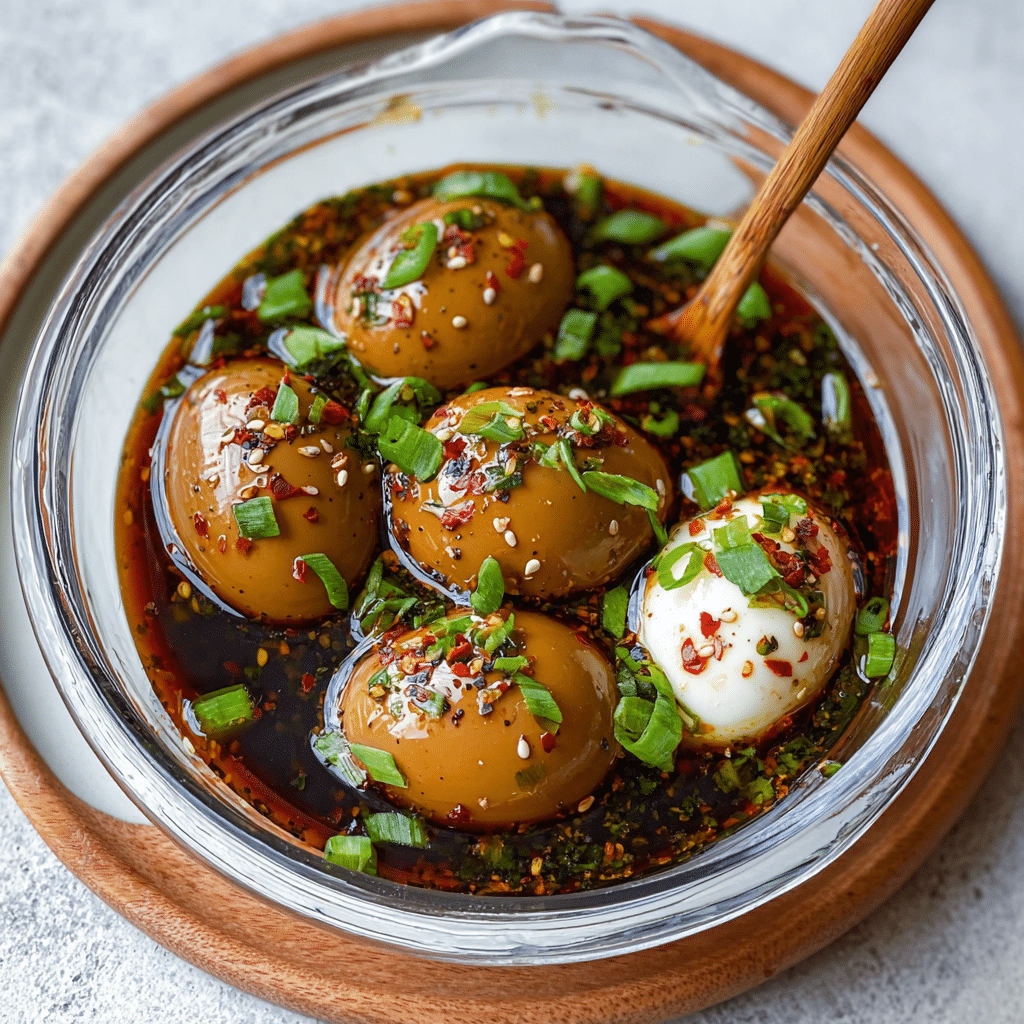The Korean Mayak Egg—literally translated as “drug egg” for its addictive nature—is a bold, savory, and slightly sweet dish that transforms humble boiled eggs into something extraordinary. With a jammy yolk at its center, the egg is steeped in a flavor-rich marinade of soy sauce, garlic, sesame oil, and a hint of chili, giving each bite a burst of umami and subtle heat.
Perfect as a rice bowl topping, lunchbox addition, or late-night snack, Mayak Eggs are a staple of Korean street food that’s now taking kitchens around the world by storm. The recipe is simple yet delivers complex flavors, making it a must-try for both beginners and seasoned foodies. Serve chilled or at room temperature—just don’t blame us if you can’t stop eating them!
Full Recipe
Ingredients:
-
6 eggs
-
1/2 cup soy sauce
-
1/2 cup water
-
1 tablespoon rice vinegar
-
2 tablespoons sugar
-
2 garlic cloves, minced
-
2 green onions, thinly sliced
-
1 tablespoon sesame seeds
-
1 Thai chili, finely chopped (optional for spice)
-
1 tablespoon sesame oil
-
1/4 onion, thinly sliced
Directions:
-
Bring a pot of water to a gentle boil. Lower the heat slightly and carefully add the eggs using a spoon.
-
Boil the eggs for exactly 6.5 minutes for jammy yolks.
-
Immediately transfer the eggs to an ice water bath to stop the cooking process. Let them sit for 5-10 minutes, then peel.
-
In a bowl or jar, mix soy sauce, water, rice vinegar, sugar, garlic, green onions, sesame seeds, Thai chili, sesame oil, and sliced onions. Stir until the sugar dissolves.
-
Add the peeled eggs to the marinade, ensuring they’re fully submerged. Use a smaller plate to weigh them down if necessary.
-
Cover and refrigerate for at least 6 hours or overnight for deeper flavor.
-
Serve the eggs over warm rice, drizzled with marinade and topped with extra green onions or sesame seeds.
Prep Time: 10 minutes | Cooking Time: 6.5 minutes | Total Time: 6 hours (including marinating)
Kcal: 90 kcal per egg | Servings: 6 servings
Introduction to Mayak Eggs: The Addictive Korean Side Dish
Mayak Eggs, often referred to as “Drug Eggs” in Korea, earn their quirky nickname not because they contain any illicit substances, but because they’re simply that addictive. These soy-marinated eggs are a staple in Korean homes, gaining popularity for their umami-rich taste, silky jammy yolks, and versatility. Typically served with a bowl of hot rice, a drizzle of marinade, and some freshly chopped scallions, Mayak Eggs are the perfect marriage of simplicity and flavor. The dish has found its way onto international food blogs and social media thanks to its easy prep and irresistible taste profile.
Cultural Origins and Popularity in Korean Cuisine
In Korean cuisine, banchan (small side dishes) play a vital role in rounding out meals. Mayak Eggs are a newer addition to this traditional lineup but have taken the food scene by storm, especially among younger generations. Originating from Seoul’s Gwangjang Market, where street vendors first introduced these marinated eggs as an affordable snack, they quickly became a household favorite due to their accessible ingredients and bold flavor.
The term “Mayak” (마약) directly translates to “narcotic” or “drug,” used figuratively to describe food that’s so good it’s addictive. This playful name speaks volumes about how these eggs impact your palate—they’re savory, slightly sweet, tangy, and deeply satisfying.
The Magic of Flavor: Why They’re So Addictive
What sets Mayak Eggs apart is the marinade. A carefully balanced mix of soy sauce, garlic, sesame oil, sugar, vinegar, and optional chili provides a flavor that’s salty, sweet, spicy, and umami all at once. As the eggs sit in the marinade—ideally overnight—they absorb all these flavors while maintaining their luscious, soft-boiled centers.
The jammy yolk acts like a sponge, drawing in the savory soy sauce and aromatic sesame, while the egg whites take on a firmer, seasoned texture. The chili adds a touch of heat without overwhelming the dish, and the raw garlic and onions lend a sharp bite that mellows as the eggs marinate.
How Mayak Eggs Fit Into Modern Meal Planning
One of the biggest appeals of Mayak Eggs is how seamlessly they fit into busy lifestyles. Whether you’re meal prepping for the week, assembling bento boxes, or looking for a quick rice bowl topping, these eggs check all the boxes. They’re quick to prepare, store well in the fridge for up to 4-5 days, and work as a protein-packed snack or a flavorful addition to meals.
They also complement various dietary needs. They’re naturally gluten-free (as long as you use gluten-free soy sauce), high in protein, and low in carbohydrates—making them suitable for low-carb, keto, or high-protein diets. And despite their simplicity, they elevate any dish they’re added to, from ramen to bibimbap to even avocado toast.
Visual Appeal and Social Media Fame
There’s no denying that Mayak Eggs have become an Instagram-worthy sensation. Their glossy, deep caramel color from the soy marinade, paired with the vibrant yellow of the jammy yolk, makes them incredibly photogenic. Food creators and influencers often share them sliced over rice or ramen, garnished with sesame seeds and green onions, capturing attention with that signature yolk drip.
The accessibility of the recipe has also contributed to its popularity. Unlike many traditional dishes that require special ingredients or techniques, Mayak Eggs require only pantry staples and a bit of patience. This makes them especially appealing to home cooks looking to dip their toes into Korean cooking.
Tips for Perfecting Mayak Eggs at Home
While the recipe is relatively straightforward, a few tips can help you perfect your Mayak Eggs:
-
Timing the Boil: The perfect jammy yolk is all about precise timing—6 to 6.5 minutes is ideal. Too short and the whites may be undercooked; too long and the yolk will set too firmly.
-
Ice Bath is Key: Transferring the eggs immediately into an ice water bath stops the cooking process and makes peeling much easier, especially with soft-boiled eggs.
-
Fresh Eggs Matter Less Here: Older eggs peel more easily than fresh ones, which is actually a benefit for this dish.
-
Flavor Development: Let the eggs marinate at least 6 hours, but overnight gives the best flavor. Some enthusiasts even prefer a two-day soak for maximum depth.
-
Spice Customization: For those who prefer a kick, adding chopped Thai chili or Korean gochugaru (red pepper flakes) to the marinade can amplify the heat.
Serving Suggestions and Pairings
Mayak Eggs are most commonly served atop a hot bowl of rice, which soaks up the flavorful marinade and complements the egg’s creamy texture. You can also:
-
Add them to a ramen bowl for a Korean twist on Japanese ajitsuke tamago.
-
Slice them and lay on top of avocado toast for a fusion breakfast.
-
Chop them up and include them in salads or grain bowls for added protein.
-
Serve them alongside steamed vegetables and kimchi for a complete Korean banchan spread.
Because of their versatility, they can be included in just about any savory dish that could benefit from a salty, umami-rich protein addition.
Health Benefits and Nutritional Insights
Mayak Eggs are a powerhouse of nutrition, especially when compared to more processed snack options. Each egg offers around 90–100 kcal and delivers high-quality protein along with essential vitamins like B12 and D, plus minerals like selenium and choline.
Their low carb content makes them an excellent snack for keto enthusiasts, and the use of wholesome ingredients like garlic and sesame oil provides anti-inflammatory and heart-healthy benefits. You control the sodium levels by adjusting the soy sauce concentration or using a low-sodium version.
Why This Dish Resonates Across Cultures
There’s something universally comforting about a well-seasoned, soft-boiled egg. Mayak Eggs manage to strike the perfect balance between East Asian flavor depth and global meal prep trends. As food culture continues to embrace fusion and simplified ethnic cooking, dishes like these become popular not only for their taste but also for their accessibility.
Western audiences are now integrating Mayak Eggs into meal prep containers, lunch bowls, and brunch dishes, showing how flexible and cross-cultural this Korean favorite can be. It serves as a bridge into Korean cooking for newcomers, while still holding a place of pride for those familiar with its origins.
Conclusion: The Small Dish That Makes a Big Impact
Mayak Eggs exemplify the beauty of Korean cooking—transforming simple, humble ingredients into something deeply flavorful and addictive. Whether you’re new to Korean cuisine or a seasoned fan, this dish offers a quick and satisfying way to enjoy bold flavors with minimal effort.
With its impressive shelf life, nutritional benefits, and unmatched flavor profile, Mayak Eggs deserve a permanent spot in your culinary rotation. From bento boxes to late-night snacks, this is a dish that proves the best things sometimes come in the smallest packages.






